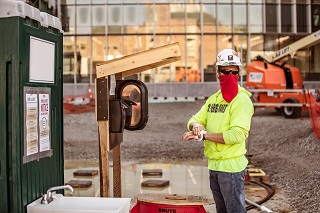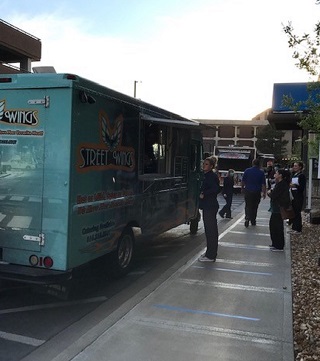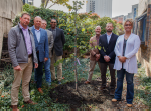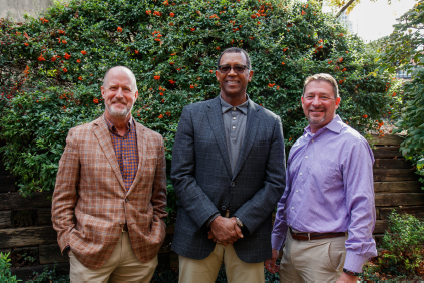Transformation
Construction industry innovates in navigating pandemic
 |
Construction was named an essential industry at the beginning of the pandemic, allowing work to continue, so employers worked quickly to put enhanced safety measures in place to protect the workforce.
Photo courtesy McCarthy Building Companies, Inc. |
The year 2020 will forever be synonymous with the pandemic — a year that both challenged us and brought us together. If the pandemic has taught us anything, it has certainly pushed our understanding of when things will be back to “normal.” When news of the coronavirus first entered airwaves, most of us thought things would level out in a few weeks. Then a few months. And yet, nearly two years later we haven’t made it back to normal, though, one could argue we’ve adjusted to this normal. Not only that, but we’ve persevered to gain control over what we can and applied flexibility and creativity to overcome what we can’t.
For this issue of Modern Builder, we are dedicating our featured story to the men and women in the construction industry who rose to the challenge to become essential to our local economies. To those of you going to a job site in uncertain times, those of you trying to navigate a virtual workplace alongside your home life, and those of you trying to quickly make decisions to create the safest workplaces possible. It has been a transformation we couldn’t see coming but that we met head-on.
AN INDUSTRY RESPONDS

Kate Ross, marketing manager at Centric, felt the support of her company in a whole new way during the pandemic. When the quarantine went into effect in early 2020, Ross felt even more uneasy about her safety. “I was newly pregnant, and as a first-time mom, especially nervous about my health and the health of my child,” she said. “Even when our office reopened, our management not only encouraged me to continue working from home, but they went the extra mile to make me feel supported and included.” Centric demonstrated their commitment to their teams by working with employees to ensure they all felt safe in their roles.
Courtesy of Centric

With so many uncertainties throughout the pandemic, everyone collectively rallied around healthcare workers on the front lines. Turner Construction Company was honored to provide services to North Kansas City Hospital to aid in helping healthcare workers, COVID-19 patients and non-COVID-19 patients stay safe. The project team consisted of six Turner staff and 13 local trade partners working 24/7 to turn over 23 negative air rooms and one UV sanitation suite in two weeks. As soon as a room was completed, a patient was brought in. The rapid turn-over allowed for a greater number of patients to be treated in COVID-19-safe areas. In addition, to show their appreciation to the North Kansas City Hospital Staff working tirelessly on the front lines, they provided over 500 meals from three local food trucks to hospital employees.
Courtesy of Turner Construction Company
NECESSITY IS THE MOTHER OF ADOPTION

Dustin Burns, vice president, information technology at McCownGordon Construction
While, for many reasons, a significant emphasis has been placed on improving technology adoption in the construction industry, it has remained somewhat slow to adopt. When the global pandemic forced construction companies to lean on their technology solutions to keep business moving, it required everyone to completely buy-in.
For McCownGordon Construction the technology groundwork had been laid and their transition to virtual went smoothly.
We made a business decision several years ago to go mobile-first and to not rely as heavily on brick and mortar,” Dustin Burns, vice president, information technology at McCownGordon says. “When the pandemic forced our office employees home and required our on-site teams to rely heavily on technology, we had the pieces in place to move into a virtual space.”
McCownGordon strategically pairs more senior employees with younger counterparts to encourage collaboration. This helps those who aren’t as tech-savvy to have quick access to someone who can help them navigate their technology solutions on job sites, like video conferencing. These relationships are mutually beneficial as seasoned employees can offer valuable work advice to their greener colleagues.
Rather than investing in new technology solutions, many companies are pushing their existing platforms to work harder. One tech element that many companies have pushed into more frequent use is 360-degree photography to offer site updates virtually. For McCownGordon, bidding new projects didn’t stop when the pandemic hit, and 360-degree photography helped mitigate the concern of not being able to visit the site in person. It is now a standard part of their process.
When the pandemic dictated strict social distancing protocols and necessitated working remotely, McCarthy Building Companies, Inc. was in the midst of managing construction for the $270 million expansion of the Tomahawk Creek Wastewater Treatment Facility, the largest project ever undertaken by Johnson County, Kansas. To help manage the project and keep all stakeholders fully engaged, McCarthy relied on the powerful, state-of-the-art technology Propeller Aero, a 3D drone photogrammetry and processing software that accurately tracks, maps, measures and analyzes a worksite with detailed accuracy.
Although McCarthy’s use of Propeller was not a result of the pandemic, the amplified use of drone technology and virtual sharing was. Propeller has continued to prove its value not only by documenting the historical stages of the project but also by projecting how the project will look in the future. For example, by blending and overlaying images taken over time it has been possible to conduct side-by-side comparisons of current conditions with those from a year or two earlier to help resolve questions and facilitate planning. Enhancing the visualization of current and future site conditions amplifies clear communication across all levels of the project team from craft to owners.
Technology will continue to advance for the construction industry to improve efficiencies, collaboration and keep teams connected.


Left: To improve technology understanding and adoption, McCownGordon pairs seasoned employees with new employees. This mutually beneficial partnership serves each employee as they navigate the learning curve associated with both technology and general job site best practices.
Right: Drone photography saw an increase in adoption during the pandemic as teams made heavier use of visual site representation tools. It offers a birds-eye view to both internal and external partners helped maintain collaboration among those on and off of sites.
Photos courtesy McCownGordon
MARKET IMPACT
As construction woes persist both locally and nationally, innovative processes are necessary
The challenges weighing on the construction industry as a result of the pandemic are apparent, and they’re coming from multiple angles. Whether it’s the decrease in spending on nonresidential construction or government mandates and vaccine hesitancy among the population, the construction industry must face hurdles from the top down.
One of the biggest challenges hanging over the industry’s head is the supply chain. The entire chain faces constraints — from manufacturing to shipping to longshoremen to container availability to container storage to real estate to truck drivers. Every aspect is under pressure, and businesses, contractors, workers and consumers feel it.
 Despite these challenges, contractors can get innovative, especially with how they plan for upcoming projects. Cornell Roofing & Sheet Metal Company is working with an owner that has approved a purchase order for materials before contracting the firm for the full job.
Despite these challenges, contractors can get innovative, especially with how they plan for upcoming projects. Cornell Roofing & Sheet Metal Company is working with an owner that has approved a purchase order for materials before contracting the firm for the full job.
“While it may be unconventional, it’s an approach that could work well in the face of current supply chain delays,” said Mary McNamara, principal at Cornell Roofing.
She explained that the contractor receives the capital needed to purchase supplies — which face lengthening lead times — early, without risk that they won’t receive payment if the job gets postponed or canceled. On the contracting owner’s end, they aren’t yet on the line for additional project expenses in the event they have to postpone the project. Instead, the contractor holds their spot in line sooner for materials, which are becoming a big factor in cost and timing for jobs.
Contractors will also need to get creative to overcome hiring and retention challenges among workers to meet
the workforce demand. Since February 2020, Missouri’s construction workforce has declined by 4,300 workers (-3.3%), according to the Associated General Contractors of America’s analysis of recent data published by the Bureau of Labor Statistics. The construction workforce in Kansas decreased by 1,100 employees (-1.7%).
Even while working through these obstacles, it’s important for contractors to be educated and aware of emerging challenges on the horizon. Business failures may rise by the end of 2022, and payment from owners may slow. To combat a shortage of cash flow, contractors need to be prepared to ask for increases to their lines of credit now.
“As we continue to learn how to operate in uncharted territory within the construction industry, it’s necessary for contractors to regularly evaluate their operational and hiring processes,” said Builders’ Board Vice Chairman Rob Cleavinger, JE Dunn Construction Company. “We have faith that our local contractors maintain the insight and expertise to make successful decisions about how to navigate their budgets, projects and workforce moving forward.”
REMEMBERING THOSE WE LOST
It is impossible to discuss the impacts of the coronavirus pandemic without acknowledging the tragic loss of life that has touched every corner of the globe. On Nov. 1, 2021, the number of deaths worldwide topped 5 million, with the U.S. accounting for about 15% of all COVID-19-related deaths.
Nearly everyone has felt the impact, and The Builders’ Association seeks ways to acknowledge the grief, give tribute to those lost, and contribute to the journey toward better living.
 Left: Builders’ President Don Greenwell spoke to AGC and Builders’ board officers at the ceremony, offering tribute to those lost and words of encouragement to survivors. Left: Builders’ President Don Greenwell spoke to AGC and Builders’ board officers at the ceremony, offering tribute to those lost and words of encouragement to survivors.
Photo by Diana Gonzalez |
 Right: Nick Johnson, son of Builders’ IT and Plan Services Director Ryan Johnson, volunteered his time to plant the tree in the courtyard behind the association’s downtown office. Right: Nick Johnson, son of Builders’ IT and Plan Services Director Ryan Johnson, volunteered his time to plant the tree in the courtyard behind the association’s downtown office.
Photo by Diana Gonzalez |
Officers from both the AGC Kansas City and Builders’ Boards of Directors gathered with association staff on Oct. 21, 2021, to dedicate a tree planted in The Builders’ courtyard in downtown Kansas City.
Eddy Whitley, Whitley Construction Company, LLC owner and Builders’ board chairman; Parker Young, Straub Construction president and AGC Kansas City board president; and Don Greenwell, Builders’ president, all offered words of comfort and hope during a ceremony.
“We dedicate this tree in memory of those in our industry and the loved ones who died over the past two years,” Greenwell said. “But this tree is also for the living, to remind us that from this difficult time, we are planting roots that will grow into a beautiful future that honors those we lost.”
The pink pom poms redbud tree was planted in view of the building’s Collaboration Room and will have a plaque placed at its base noting the dedication.
“Watching this tree grow I will be reminded of the struggles we faced the past two years and instead of tears, I will smile,” said Brandy McCombs, principal at IBC, Inc. and Builders’ board assistant chairworman. “I lost my mom recently and the planting of this tree symbolizes the roots she planted within me.”
INDUSTRY TRANSFORMED
The pandemic has transformed the construction industry and many best practices identified at the height of quarantine remain effective tools today. With an industry deemed essential, local companies rose to the challenge to create safe sites for employees to effectively do their jobs. And while it felt uncertain and scary, teams came together and did their best.
As we look forward to what’s next, we know better than to apply specific time frames. Instead, companies continue to remain nimble and prepared.
Competition for talent continues to be a major concern for construction companies moving forward. Finding a balance between maintaining a distinctive culture while also offering flexibility in remote and in-person opportunities will be key to attracting and retaining talent.
This new “cameras on” world has given employees a glimpse into everyone’s home life and in addition to bringing teams together to collaborate, it also had another interesting side effect.
“It created a real sense of empathy for each other,” Burns said. “We were all going through something together and trying our best to balance our home and work lives on top of each other.
We became a lot more understanding of what each of our teammates was going through, and I think that helped strengthen our relationships with each other.”

TRANSFORMATION: LETTER FROM LEADERSHIP
 |
(Pictured left to right) Don Greenwell, The Builders’ Association president; Builders’ Board Chairman Eddy Whitley, principal at Whitley Construction Company, LLC; AGC Kansas City Board President Parker Young, Straub Construction president.
Photo by Diana Gonzalez |
TO THE MEMBERS OF THE BUILDERS’ ASSOCIATION AND AGC,
As each year comes to a close, it prompts reflection: It’s an opportunity to take stock of where you’ve been, what goals you achieved,
and what goals still require attention. It’s also a time to look forward and set intentions for where you want to be at this same time in a
year or beyond.
We know we are not alone in saying that reflecting on the past year or so feels different this year. We have experienced the loss of friends and colleagues around the industry as well as in our personal lives, while also working to lead our organizations through one of the most challenging and complicated periods of our lives.
While acknowledging the difficulties this moment has presented, we wanted to pen this letter to membership to end the COVID-19 transformation feature on a note of hope.
We’re hopeful because we’ve seen this industry knocked down before, and we know our colleagues and workforce have the grit to meet this challenge too. The pandemic has created a population of survivors who have had to be more creative than ever to overcome each new hurdle set in their path. That creativity, strength of character and determination will carry us to new heights as we find new ways to perform our work and collaborate.
The desire to connect and collaborate in seeking solutions to advance the industry has been inspiring to watch. As leaders in this association, our success is dependent on the caliber of those by whom we are surrounded, and there is no question that we are surrounded by the best.
We are blessed to have a wealth of expertise in all areas of the association, and those experts are working hard to provide knowledge and resources required to reduce uncertainty. The more each member organization can plan ahead, mitigate risk and source new business opportunities, the more likely our industry is to prosper. The Builders’ and AGC Kansas City are prepared to do all they can to provide exactly those things to members.
We are grateful for the dedication and commitment shown by Builders’ and AGC member organizations, board members and staff to guide us through this unprecedented period.
A heartfelt thanks from each of us to each of you, with wishes for joyous holidays and a prosperous and healthy new year.
With gratitude and hope,